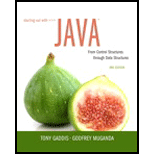
Starting Out with Java: From Control Structures through Data Structures (3rd Edition)
3rd Edition
ISBN: 9780134038179
Author: Tony Gaddis, Godfrey Muganda
Publisher: PEARSON
expand_more
expand_more
format_list_bulleted
Expert Solution & Answer
Chapter 20, Problem 3SA
Explanation of Solution
Index of an element in a list:
- In a list, the index of an element implies the zero-based position of the element.
- A list is a collection that stores its element in a location-based order.
- Each element in a list is related with an index that matches to its location within the list. That is the first element has index 0, the second element has index 1 and so on...
Expert Solution & Answer
Want to see the full answer?
Check out a sample textbook solution
Students have asked these similar questions
Pllleasassseee ssiiirrrr soolveee thissssss questionnnnnnn
Pllleasassseee ssiiirrrr soolveee thissssss questionnnnnnn
Pllleasassseee ssiiirrrr soolveee thissssss questionnnnnnn
Chapter 20 Solutions
Starting Out with Java: From Control Structures through Data Structures (3rd Edition)
Ch. 20.1 - Prob. 20.1CPCh. 20.1 - Prob. 20.2CPCh. 20.3 - Prob. 20.4CPCh. 20 - A list is a collection that _____. a. associates...Ch. 20 - Prob. 2MCCh. 20 - Prob. 3MCCh. 20 - Prob. 4MCCh. 20 - Prob. 5MCCh. 20 - Prob. 6MCCh. 20 - Prob. 7MC
Ch. 20 - Prob. 11TFCh. 20 - Prob. 12TFCh. 20 - Prob. 13TFCh. 20 - Prob. 14TFCh. 20 - Prob. 15TFCh. 20 - Prob. 16TFCh. 20 - Prob. 17TFCh. 20 - Prob. 18TFCh. 20 - Prob. 29TFCh. 20 - Prob. 20TFCh. 20 - Prob. 1FTECh. 20 - Prob. 2FTECh. 20 - Prob. 3FTECh. 20 - Prob. 4FTECh. 20 - Prob. 5FTECh. 20 - Prob. 1AWCh. 20 - Prob. 2AWCh. 20 - Prob. 3AWCh. 20 - Prob. 4AWCh. 20 - Prob. 3SACh. 20 - Prob. 4SACh. 20 - Prob. 5SACh. 20 - Consult the online Java documentation and...Ch. 20 - Prob. 1PCCh. 20 - Prob. 2PC
Knowledge Booster
Similar questions
- Pllleasassseee ssiiirrrr soolveee thissssss questionnnnnnnarrow_forward4. def modify_data(x, my_list): X = X + 1 my_list.append(x) print(f"Inside the function: x = {x}, my_list = {my_list}") num = 5 numbers = [1, 2, 3] modify_data(num, numbers) print(f"Outside the function: num = {num}, my_list = {numbers}") Classe Classe that lin Thus, A pro is ref inter Ever dict The The output: Inside the function:? Outside the function:?arrow_forwardpython Tasks 5 • Task 1: Building a Library Management system. Write a Book class and a function to filter books by publication year. • Task 2: Create a Person class with name and age attributes, and calculate the average age of a list of people Task 3: Building a Movie Collection system. Each movie has a title, a genre, and a rating. Write a function to filter movies based on a minimum rating. ⚫ Task 4: Find Young Animals. Create an Animal class with name, species, and age attributes, and track the animals' ages to know which ones are still young. • Task 5(homework): In a store's inventory system, you want to apply discounts to products and filter those with prices above a specified amount. 27/04/1446arrow_forward
- Of the five primary components of an information system (hardware, software, data, people, process), which do you think is the most important to the success of a business organization? Part A - Define each primary component of the information system. Part B - Include your perspective on why your selection is most important. Part C - Provide an example from your personal experience to support your answer.arrow_forwardManagement Information Systemsarrow_forwardQ2/find the transfer function C/R for the system shown in the figure Re དarrow_forward
- Please original work select a topic related to architectures or infrastructures (Data Lakehouse Architecture). Discussing how you would implement your chosen topic in a data warehouse project Please cite in text references and add weblinksarrow_forwardPlease original work What topic would be related to architectures or infrastructures. How you would implement your chosen topic in a data warehouse project. Please cite in text references and add weblinksarrow_forwardWhat is cloud computing and why do we use it? Give one of your friends with your answer.arrow_forward
- What are triggers and how do you invoke them on demand? Give one reference with your answer.arrow_forwardDiscuss with appropriate examples the types of relationships in a database. Give one reference with your answer.arrow_forwardDetermine the velocity error constant (k,) for the system shown. + R(s)- K G(s) where: K=1.6 A(s+B) G(s) = as²+bs C(s) where: A 14, B =3, a =6. and b =10arrow_forward
arrow_back_ios
SEE MORE QUESTIONS
arrow_forward_ios
Recommended textbooks for you
 Systems ArchitectureComputer ScienceISBN:9781305080195Author:Stephen D. BurdPublisher:Cengage Learning
Systems ArchitectureComputer ScienceISBN:9781305080195Author:Stephen D. BurdPublisher:Cengage Learning

Systems Architecture
Computer Science
ISBN:9781305080195
Author:Stephen D. Burd
Publisher:Cengage Learning